#Ancient Roman religion
Text
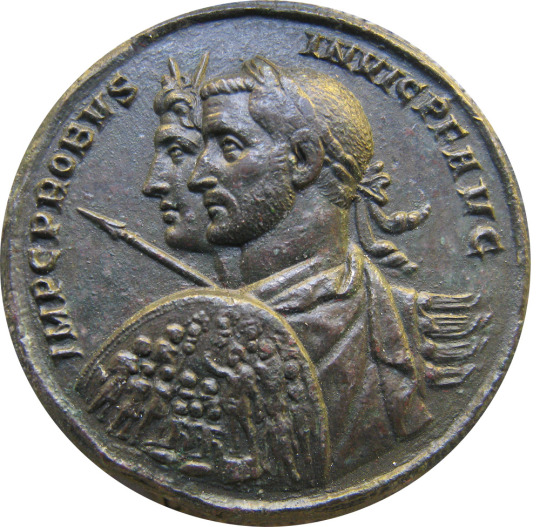
Coin minted ca. 280 CE by the Roman emperor Marcus Aurelius Probus (r. 276-282). Probus is shown in the company of Sol Invictus ("Unconquered Sun"), a late form of the solar deity whose worship had been promoted by Probus' predecessor Aurelian. The birthday of Sol Invictus (Dies Natalis Solis Invicti) was traditionally celebrated on Dec. 25. On this coin, Probus, who was constantly on campaign during his brief reign, is shown prepared for battle with shield and spear, alongside Sol Invictus, who wears his characteristic radiant crown. Now in the National Museum of Denmark, Copenhagen. Photo credit: ChrisO/Wikimedia Commons.
#classics#tagamemnon#Ancient Rome#Roman Empire#ancient history#Roman history#Probus#M. Aurelius Probus#Roman religion#Ancient Roman religion#religio Romana#Sol Invictus#art#art history#ancient art#Roman art#Ancient Roman art#Roman Imperial art#coins#ancient coins#Roman coins#Ancient Roman coins#numismatics#ancient numismatics#Roman numismatics#National Museum of Denmark
307 notes
·
View notes
Text
a little summary for the non-Italian-speaking folks who'll run into this post:
a capitolium - a tripartite temple, that is - has been discovered in the city of Sarsina, province of Forlì-Cesena, Italy. it most likely dates back to the 1st century BCE. more studies will be done on the building, which will probably lead to a deeper understanding of ancient Roman religion.
#roman paganism#roman polytheism#roman pantheon#religio romana#cultus deorum#roman polytheist#ancient roman religion#paganism#roman religion#archeology
22 notes
·
View notes
Text
January God
In ancient Roman religion and mythology, Janus is the god of beginnings and transitions, thence also of gates, doors, doorways, endings and time. He is usually a two-faced god since he looks to the future and the past. The Romans dedicated the month of January to Janus. His most apparent remnant in modern culture is his namesake, the month of January.
The Nobel Prize winning poet, Seamus Heaney,…

View On WordPress
#&039;January God&039;#Ancient Irish History#Ancient Roman Religion#Boa Island#Co. Fermanagh#Eniskillin#From Cruach#Ireland#Irish History#January#Janus Figure#Mythology#Seamus Heaney#The Secret of Kells
7 notes
·
View notes
Note
Myths aside and out of curiosity, did any ancient Greeks worship Cronus the same way the Romans saw Saturn?
I found some references to Kronos' veneration in Chaironeia, Pelion, Thebes, Arcadia and Minor Asia coast. In Olympia there was Kronios Hill, where they did sacrifices, and in Athens there was the sanctuary of Kronos and Rhea next to Zeus' temple.
We have information that the Athenians celebrated Kronia (Κρόνια), which later became the Roman festival of Saturnalia. It was at the beginning of the year (in the Εκατομβαιών month), towards the end of our modern July. It commemorated the time Kronos and Ilios (the sun) reigned upon the earth, the Golden Age of the Human Race, when there were no slaves and masters. That day the slaves could sit on their masters' tables, and sometimes the masters served the slaves. It was a festival to give thanks for the fertile earth and ask for a good harvest for the year to come. It's very possible that some of the Greek New Year traditions like singing kalanda and using/breaking pomegranates for good luck and fertility hail from the festival of Kronia.
That's some condensed information but I hope it's enough for you to start your search!
84 notes
·
View notes
Text
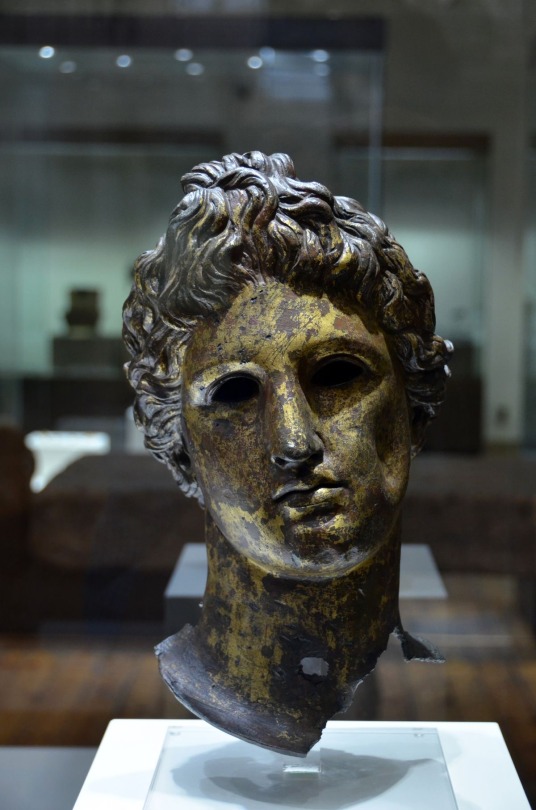
Roman period Head of Apollo
#apollo#ancient rome#art#gods#roman#roman mythology#religion#history#europe#european#thrace#thracian#serdica#serdika#sofia#bulgaria#archaeology#bulgarian#museum#olympian#deity#deities#greek mythology#mythology#olympians
3K notes
·
View notes
Text
0 notes
Text
While checking around for my “Roman gods are not Greek gods” posts, I found back this tripartition of mythology, which is actually a fact that everybody should kno about if they want to dabble in Greco-Roman myths (especially Greek myths).
We know that, during Antiquity, the Romans and the Greeks thought that there wasn’t just one, but three different types of “theology” - three different views, perceptions and reception of the gods.
The first theology was the theology of the priests and of the state - aka, religion. The Greek gods as perceived and described by religion, as honored through rituals and festivals.
The second theology is the “mythic theology” - what we call “mythology today”. It is a set of legends, folktales and stories that are not part of religion, but rather used and carried by art - it is the gods are seen, perceived and described by the poets, by the epics, by the theater plays.
The third theology is the theology of the philosophers - who used the gods and their tales as images and allegories for various abstract or concrete topics. It is the gods as depictions and description of natural phenomenon, or the myths as a way to actualy exemplify a social fact or explain psychological workings.
For the classic Greeks and Romans, there was a clear divide between those three very different point of view of the gods. It was basically three different versions of the pantheon. This is notably why you will find texts noting that priests disliked and condemned the poets’ mythological works, due to them being blasphemous and making the gods too human when religion described them as perfect ; and it is also why the philosophers of old dissed on and rejected the literary works of mythology as nonsense only good to feed superstitions, because for them the gods weren’t characters or realities, but rather abstract concepts and rhetorical allegories.
This is something I feel needs to be reminded, because today these three different theologies have been mixed up into one big mess - as literary myths are placed one the same level as philosophical “myths” (actually texts taking the shape of myths), and both considered of outmost religious importance. When in fact, things were quite different...
EDIT: I was asked if there was a myth that could illustrate the three different theologies, and on the spot I would say “the affair between Aphrodite and Ares”.
This story originates from the “mythological theology”. It is primarily a story, and a good one. It is the story of a husband who discovers his wife is unfaithful and tries to get revenge, it is the story of an extra-marital affair gone wrong, it is typical set of divine shenanigans ending on a grotesque display of divine humiliation - it is an excellent narrative material for plays and poems (and the legend does originates from poems).
The story was also dearly beloved and reused by the “philosophical theology”, because the philosophers adored the idea of the love between Ares and Aphrodite - for them it was the perfect depiction of how the concepts of “love” and “war” , despite being seemingly opposite, attracted each other and were closely tied. For them, this story isn’t to be taken literaly as “a god cheated on another god”, but rather as “this is an allegory showing that love and war are two sides of the same coin, which is why Aphrodite falls for Ares despite being married to Hephaistos”. But for them the whole net part is just poetic nonsense invented to make people laugh ; or maybe they will reinvent them as a moral, cautionary tale that should be used to warn people of the dangers of unfaithfulness.
And then there’s the “religious theology”, the point of view of the priests - for whom such a story is mockery and sacrilege. You can imagine them saying: “You are making the gods look like fools! Gods don’t cheat on each other, gods don’t get captured in nets while butt-naked, gods don’t even sleep on beds - GODS DO NOT EVEN HAVE HUMAN FORMS IN THEIR NATURAL STATE - what the heck is this bullshit you’re saying, you’re just insulting the gods by turning them into lecherous humans and grotesque clowns for your vulgar story!” (This is a reconstitution and not the actual words of an Ancient Greek priest)
#greek gods#roman gods#greek mythology#greek religion#roman mythology#roman religion#ancient theology
611 notes
·
View notes
Text


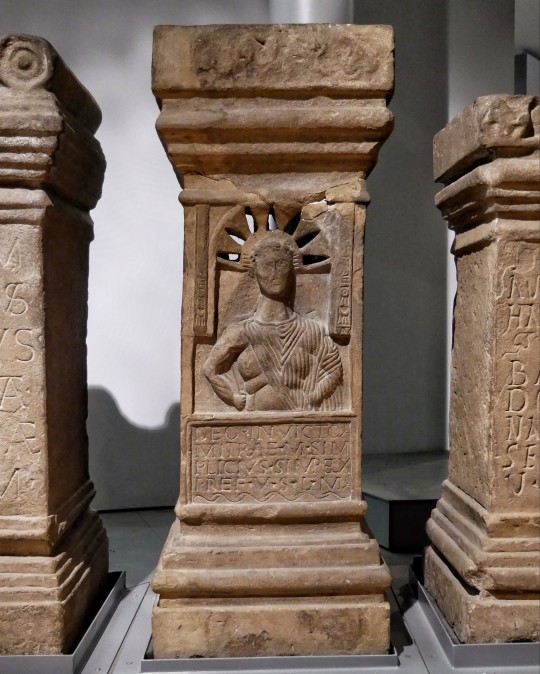
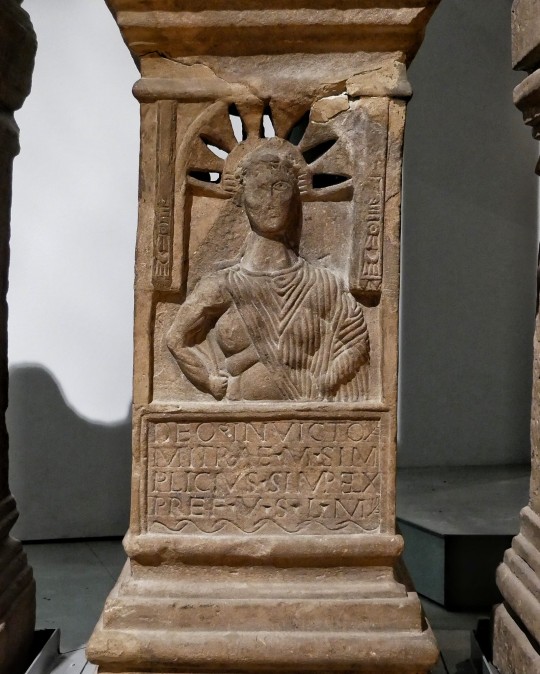
Roman Altar found in Carrawburgh Mithraeum, Hadrian's Wall, Great North Museum, Hancock, Newcastle upon Tyne
#roman#roman army#roman fort#roman altar#hadrian's wall#archaeology#roman relic#roman religion#romans#deity#mithras#mithraeum#ancient cultures#ancient living#Northumberland
191 notes
·
View notes
Text
On Janus, the two-faced Roman god of beginnings
Or: how January got its name & why you shouldn’t give up on your New Year’s resolutions just yet
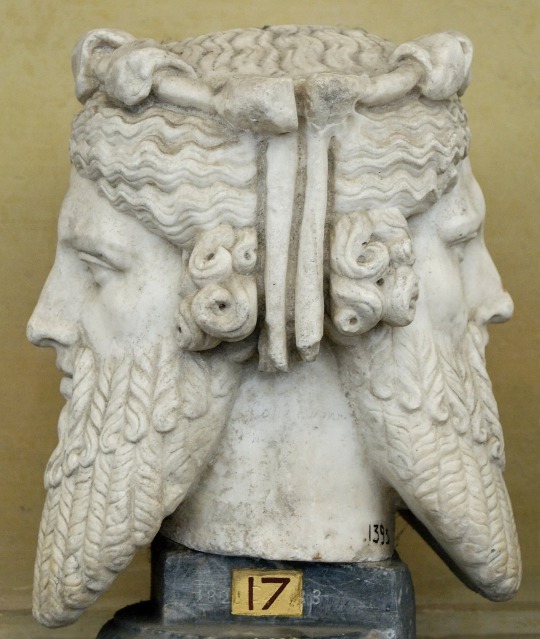
Now that we’re more than halfway through January, how are your New Year’s resolutions coming along?
If you’re anything like most of us, your resolve may be getting shaky.
According to a recent Forbes survey, the average resolution lasts a mere 3.74 months, and only 6% of people stick with their goals long term.
But you know what?
Even if you’ve failed to live up to your resolutions less than a month into 2024, that’s fine. Don’t give up on yourself just yet.
Here’s an unlikely source of hope and motivation to get back up again and keep at it in the guise of one lesser-known (undeservedly!) Roman deity.
#ancient history#history#ancient civilizations#ancient rome#roman empire#history of religion#classical mythology#roman mythology#mythology and folklore#roman gods#january#new year’s resolution#antiquity#classical antiquity
120 notes
·
View notes
Text
TIL from a podcast featuring historian and Byzantine archaeologist Yannis Theoharis:
Athens was one of the most religiously conservative cities of the Byzantine Empire. It adhered to the ancient Greek religion for longer than most other areas. Contrary to popular belief, its eventual conversion to Christianity did not happen violently. Christianity was getting more and more ground amongst the believers progressively. Meanwhile, the ancient temples and shrines were progressively emptying but as long as there were believers they were functioning properly and had guards and went through restoration works and all, as stated by Neoplatonic philosopher Proklos (with the exception of nude sculptures which had been destroyed already by proto-Christians). The historian also claims the conversion of the temples to churches happened later than what was previously believed, around the 7th-9th centuries. As the vast majority of the population had eventually converted to Christianity, the temples were left abandoned. The empire ordered their conversion to churches so that funding their preservation could be justified. Furthermore, there wasn’t as much of violent banning of ancient schools as it was thought. Justinian did not ban the function of the Neoplatonic school in Athens but ceased the state funding unless the school accepted to add Christian theology to its curriculum. The Neoplatonic school refused but it was not banned. It kept functioning using its own private funds until this wasn’t enough and the school had to close. Evidence for this is that it is documented that the school functioned for several decades or more than a century (don’t remember exactly) after Justinian’s imperial command, which was previously viewed as an immediate or violent shutdown. Meanwhile, the Neoplatonic school in Alexandria (in Egypt) agreed to add Christian theology to its curriculum and it kept functioning undisturbed until the 7th century and the Arab conquest.
Also, he has more insight into the similarities observed between Eastern / Greek and even all Orthodoxy and the Ancient Greek religion, such as idol / icon worship, lesser deity / saint worship, virgin female deity / super saint worship, patron gods / saints etc He says there was an interesting cycle of Christianised Hellenism followed by Hellenized Christianity. Some of these elements of Christian Orthodoxy were emphasized more than in the early years of Proto-Christianity or even exaggerated by the Byzantine Greek Christians in order to attract the pagan Greeks and make them understand more easily the philosophy of the new religion and find common ground between them. It worked.
Lastly, he disputed the dated assumptions that the Visigoth king Alaric I was assisted by monks to destroy Athens during his invasion in 396. This was falsely concluded because in documents it was found that Alaric was accompanied by men clad in black. Theoharis says these were actually Thracian soldiers (Alaric indeed fared long in Thrace and the Thracians were by large mercenaries) and supports it is very unlikely based on historical evidence of the time that Athenian or Greek Christians would collaborate with a Visigoth invader to help him destroy historical areas of Athens, even if they were pagan.
These are the most important bits from memory, I am linking the podcast here, it is in Greek.
#Greece#Europe#history#Greek history#Byzantine history#Christian orthodoxy#Ancient Greek religion#Greek orthodoxy#Eastern Orthodoxy#Byzantine empire#eastern Roman Empire#justinian#Alaric I#proklos#neoplatonism#Athens#attica#central Greece#Sterea Hellas#mainland
86 notes
·
View notes
Text

The god Hesperus sits on a throne and holds a tall torch. Around him are Apollo-Helios (identifiable by his halo), Aphrodite (crowned), and other deities. Wall painting in the Fourth Style from the exedra of the House of M. Gavius Rufus (VII.2.16) at Pompeii; now in the National Archaeological Museum, Naples. Photo credit: ArchaiOptix/Wikimedia Commons.
#classics#tagamemnon#Ancient Rome#Roman Empire#Pompeii#Greek religion#Ancient Greek religion#Hellenic polytheism#Roman religion#Ancient Roman religion#religio Romana#Dionysus#Dionysos#Helios#Aphrodite#art#art history#ancient art#Roman art#Ancient Roman art#Roman Imperial art#wall painting#fresco#Fourth Style#NAM Naples
522 notes
·
View notes
Text
a brief summary for English-speakers:
back in Ancient Rome, Caligola had two ships built in Lake Nemi to host the cult of goddess Isis (I have already discussed this in my post about Diana and Nemi). both crafts eventually sinked, and it took hundreds of years to successfully get them out.
it took three years to get them out, from 1929 to 1931. very unluckily, though, the ships were lit on fire in 1944, during WWII. many speculations surrounded the accident: some folks believed that a couple of kids were responsible, others would claim that it had been the Germans trying to escape.
the mystery has now been solved, apparently, thanks to archaeologist Flavio Altamura and historian Stefano Paolucci. after analysing the evidence carefully, it was discovered that the American army had bombed the museum where the ships were held to destroy a German settlement, filled with weapons.
#roman paganism#roman polytheism#roman pantheon#religio romana#cultus deorum#roman polytheist#paganism#ancient roman religion#roman pagan#roman religion#world war ii#world war 2#history#ancient rome#contemporary history
4 notes
·
View notes
Text
January God
In ancient Roman religion and mythology, Janus is the god of beginnings and transitions, thence also of gates, doors, doorways, endings and time. He is usually a two-faced god since he looks to the future and the past. The Romans dedicated the month of January to Janus. His most apparent remnant in modern culture is his namesake, the month of January.
The Nobel Prize winning poet, Seamus Heaney,…

View On WordPress
#&039;January God&039;#Ancient Irish History#Ancient Roman Religion#Boa Island#Co. Fermanagh#Eniskillin#From Cruach#Ireland#Irish History#January#Janus Figure#Mythology#Seamus Heaney#The Secret of Kells
16 notes
·
View notes
Text
the book trend that needs to be left in the dust for the new year is greek mythology retellings. i am so sick and tired of "retellings" of greek (or roman, but mainly greek) mythology from authors that clearly have a very surface level pop cultural understanding of the myth(s) they're adapting and the culture(s) they're depicting. especially the many that market themselves as "feminist retellings" where the "feminism" is basically just "men bad sometimes", and especially when they're "feminist retellings" that take some of the few mythological women who get happy endings and take it away from them for the sake of saying "men bad sometimes". it's all so shallow and they exploded this year and i'm sick of it.
#i wish so fucking much to read one (1) singular actually good feminist retelling of greek mythology#but they're always so shallow both in their messaging and their understanding of ancient greek culture and religion#i speak#anti booktok#sort of anyway?#greek mythology#bc i can't make a single post tangentially about myth without bitching about medusa:#so many people in publishing clearly got everything they learned about medusa from popular online depictions#and especially the books that are specifically about medusa blending greek and roman mythology despite them having very distinct elements
144 notes
·
View notes
Text


Head of Ares
#ares#mars#art#scultpure#sculptures#roman#marble#europe#european#history#ancient greek#borghese#ancient greece#gods#god of war#religion#mythology#religious#ancient rome#roman empire#mythological#religious art
436 notes
·
View notes
Text

Part of a relief portraying goddess Isis, a hellenized version of an ancient Egyptian goddess Eset. After Romans turned Egypt into a province, the cult of Isis spread all over the Roman Empire and reached its peak during the second century.
#ancient rome#roman empire#ancient history#ancient culture#ancient egypt#isis#goddess isis#ancient religion
67 notes
·
View notes